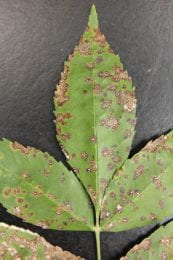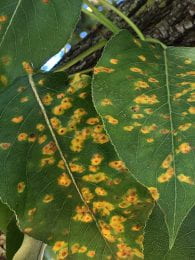By: Christian Webb
You may notice brown spots beginning to develop on the lower foliage of green ash trees. Symptoms of Ash leaf spot include irregularly shaped brown spots on the leaf that merge to form large patches of brown spots. In severe cases, the tree may defoliate four to six weeks earlier than normal causing the tree to appear bare long before other trees lose their leaves.


Pictured above on the left: A branch of lower leaves on an Ash tree affected by leaf spot. Right: Brown leaf spots with white speckling on the surface of the upper leaf caused by Ash leaf spot
The fungi that cause Ash leaf spot (Mycosphaerella spp.) survive in the leaf litter underneath the ash tree. In the early summer, the fungi in the leaf litter will begin producing spores capable of infecting leaves. Initial infections will appear on the lower leaves, and then quickly spread throughout the tree. By late fall, the fungus will produce structures able to survive the harsh conditions of winter and be ready to infect new leaves during the following summer.

The severity of the disease will depend on the conditions present during the period of leaf infection. Typically, the disease will become apparent in the late summer and early fall, which may not cause significant cosmetic damage. But in summers with abnormally wet conditions, the disease may develop earlier than normal and cause premature defoliation. Multiple years of these conditions may lead to weak trees with reduced vigor prone to branch dieback.
Pictured above: A microscopic image of fungal structure emerging from the surface of the leaf.
There are few recommended methods to protect ash plantings from Ash leaf spot. Since the disease will survive in the residue around the trees, raking up fallen leaves will reduce the amount of disease carried over to the next growing season. No ash trees resistant to leaf spot have been reported although they may vary in susceptibility.
Reference:
More information on Ash leaf spot may be found at the following Link on page 46-47. https://www.fs.fed.us/rm/pubs/rmrs_gtr335.pdf











 The best time to test for oak wilt is when trees are freshly wilted, generally in the spring.
The best time to test for oak wilt is when trees are freshly wilted, generally in the spring.
 By: Judy O’Mara
By: Judy O’Mara I look forward to the annual exploding London plane trees (and sycamore) on the K-State campus. Sometime during early to mid-July the outer bark slips off the tree…explosively. Bark pieces can wind up 20 feet away. The first time I saw this interesting event (30 yrs ago), I was worried that the tree was going to die. I’ve since learned that this is just a normal growth habit of the tree.
I look forward to the annual exploding London plane trees (and sycamore) on the K-State campus. Sometime during early to mid-July the outer bark slips off the tree…explosively. Bark pieces can wind up 20 feet away. The first time I saw this interesting event (30 yrs ago), I was worried that the tree was going to die. I’ve since learned that this is just a normal growth habit of the tree.





 Many plants with poor growth this summer have been suffering due to saturated soils and high temperatures. However, sometimes plant decline is due to a disease. This Coreopsis bed sustained damage from a fungal disease called Rhizoctonia crown and root rot. The disease can survive in the soil for long periods and is triggered by high temperatures and moist soils. Long-term the best management option is to start over with new Coreopsis plants in a new location.
Many plants with poor growth this summer have been suffering due to saturated soils and high temperatures. However, sometimes plant decline is due to a disease. This Coreopsis bed sustained damage from a fungal disease called Rhizoctonia crown and root rot. The disease can survive in the soil for long periods and is triggered by high temperatures and moist soils. Long-term the best management option is to start over with new Coreopsis plants in a new location.





 Anthracnose on hosta will show up as brown scattered spots. The centers sometimes drop out creating a shot hole appearance. Like all fungal diseases, it has been favored by the wet conditions this spring.
Anthracnose on hosta will show up as brown scattered spots. The centers sometimes drop out creating a shot hole appearance. Like all fungal diseases, it has been favored by the wet conditions this spring.




